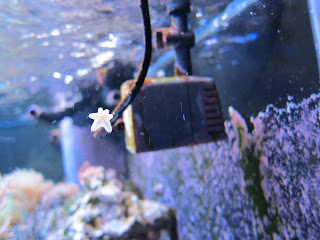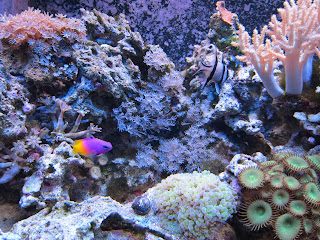We have a lot of catching up to do on the home aquarium start. The tank is officially a year old! It's definitely been a success but not without its share of ups and down. On the whole, the aquarium centers around an equilibrium that cannot be greatly disturbed for sustainability. Today, I'll go into the nitty gritty. Stay tuned for an exciting ride!
First, let's get the stats over with: Temp 78-79.
pH 8.4
S.G. 1.025
Calcium 520 ppm
Alkalinity 5 dkH (used to be 7-8, although 8 was a fight)
(Why is my calcium good but alkalinity low?)
Ammonia 0
Nitrites 0
Nitrates ~5 ppm
Since Louie and Scooter both disappeared about a week ago, unfortunately, I decay the rise in nirates to increased decomposition. I've never recorded a nitrate concentration before. Returning to small weekly water changes for now will reduce nitrate levels and address the other issues as well (S.G., pH, Ca2+, alkalinity).
Routine Care:
Daily: feed fish, check water levels (fill automatic top-off--Note to Self--purchase larger ATO container!), check temp and lights.
Every 2 Days: clean skimmer cup
Weekly: Dose calcium and alkalinity. I dosed with 10 mL of B-Ionic Buffers 1 & 2 today to raise the calcium/alkalinity. This is generally needed about 1x/week. Water changes help too. Alternatively, there are these rad little blocks that you can put in your sump to raise calcium levels. They dissolve as needed and are supposed to be foolproof. However, there is some controversy out there on the "blocks". It is generally recommended to dose weekly.
Feed coral. My elegance coral is a pretty big eater. I sometimes only feed coral every other week since I feed my tank every day. Typically, I feed coral the day or two before a scheduled water change.
2x/Month: 20% water change. Alternatively, I change 10% weekly. Change filter sock upon water change. Remove ~1-5% of old refugium macroalgae to encourage growth Kill any prominent aiptasia
Monthly: More vigorous cleaning of tank during water change to remove algae. Replace activated carbon in media reactor. More vigorous cleaning of protein skimmer.
Bi-Annually: Change bulbs. Clean out powerheads and pumps. Check and clean all equipment.
Onto some sad news: Louie and Scooter in memorium. Both of these fish were my favorites. They were part of the original crew that were first introduced to the tank. Both grew and thrived over the last year. I had begun to take their boisterous, ever-constant presence for granted. When they disappeared, first Louie, then Scooter, it was very sudden, unexpected, and heartbreaking. I have no idea what happened, and I've been racking my brain.
Could Louie, the yellow coris wrasse, have jumped from the tank? Perhaps, but I've searched everywhere, including the floors, overflow, filter sock, sump, refugium, and pumps. Plus, my dog didn't find anything, and there was never a smell. Unlikely. Could something have eaten them? What? I haven't seen anything, I don't have anything that would eat something that big (Louie) or slimy (Scooter, the scooter blenny, is covered in a thick film of mucous and generally distasteful to other carniovores) Could they have both starved to death? Also, unlikely because I watched them both eat constantly. They both loved Cylop-eze but they became omnivorous over time. Both loved picking at the live rock. Plus, I have a refugium. Could the refugium have crashed? I still see a healthy population of pods, so, again, unlikely. Could Louie have buried himeself in the sand? Not if he was healthy. He was big and active, quite used to swimming around, out front and center all day, and running the show. If he had become weak or ill, he would have buried himself in my (deep) sandbed to die.
Unfortunately, I will never know. All I can do is follow my procedure for tank care after unexpected death of a fish. Check all water parameters. Perform a 15-20% water change. Watch remaining fish carefully. (Note: Entire tank readings are normal and fish and coral look delightfully happy.) Wait at a least a month before adding any new inhabitants to allow tank to return to homeostasis.
I miss you guys, Louie and Scooter! Ironically, they used to "hang out" together. They are probably up in fish heaven right now, feasting off the live rock. Louie as a baby. So tiny!

Louie all grown up (about 2x the original size!), hovering over Scooter (also doubled in size). In addition, Scooter's colors darkened to a purple/brick-red.

Louie teasing Scooter, as he often did. They loved hanging out.

Scooter proudly showing his huge dorsal fin. So that's why they call you a "Peacock Dragonet"!

Current Inhabitants:
Fish
Pedro--bluejaw trigger (not as shy as he used to be; very friendly; I call him "the sherrif".)
Casey--pugnacious flameback dwarf angel who has decided my open brain coral is dessert. However, she doesn't touch any of my other corals. She's quite striking and her beauty has earned her the right to be a diva.
Felipe--royal gramma (shy but plucky)
Bonnie & Clyde--mated pair of captive-bred clowns (Oscellaris).
When they were babies, I couldn't tell which one was Bonnie but now, it's pretty obvious (the larger and more aggressive of the 2).
Toby--Scopas Tang (shy and great algae eater. A quiet beauty)
Earl--lawnmower blenny (great algae eater. colors have become more vivid and size has more than doubled since I first got him! He's quite a character, jumping around and banging his head against the rocks.)
Hazel--purple firefish (shy but starting to come out of her shell. She loves hanging out in "mushroom city", the more quiet, lower flow part of the city).
Mr. & Mrs. Roper--both actually are males; an unlikely pair of Bangaii cardinalfish. One became dominant, and they comfortably (albeit begrudgingly) coexist in the same tank.
Nahla--bluestreak cleaner wrasse. She's makes up for her smallish size with amazing speed and dexterity. She eats just about anything, and it shows in her rosy, round belly. Not shy at all, she enjoys hanging out with Pedro and pecking at my hand and arm when I clean the tank.
Inverts
Purple Collector Sea Urchin:
nocturnal and great algae eater. Some complain that these guys eat all their corralline algae. I have a ton of coralline algae since I first introduced him. Sure, he eats it but he also spreads it around and helps it grow. He does sometimes abscond with a coral frag that hasn't been securely fastened to the live rock.
3 Skunk Cleaner Shrimp:
The Merry Maids, Merry, Marie, and Marty. These guys are my favorites! They are quite tame, and jump all over my hand and arms when I'm cleaning the tank. They are great at cleaning up messes! In addition, they set up cleaning stations (Merry's Car Wash) and give Pedro, Toby, Cassie, and other fish vigorous scrubbings.
Coral
Mushrooms (all types and colors. They thrive in "Mushroom City", the low-flow, quiet corner of the tank. Back there, they are growing like weeds.)
Toadstool
Elegance Coral
Frogspawn
Zooanthids (various greens and reds. They prefer lower flow sections of the tank).
Button polyps (beautiful greens and reds, growing rapidly, it enjoys weekly feedings).
Pink zoanthid colony that thrives in a high-flow section of the tank where nothing else grows. Here it has tripled in size.
Daisy Polyps
Xenia (colony no longer pulsing but still healthy appearance and some (although slower) growth) Clove Polyps (Clavularia)
Leather Coral
Red Plate Coral (likes high flow, high light)
Now for the best part!
The pics:
1 year later: my aquarium
Right-hand side of aquarium (Bonnie & Clyde, Leather, Button Polyps, and Pink Zoanthid Colony shown here)
Pedro, the bluejaw trigger, hanging out in his favorite feeding spot.

Side view of aquarium. Bonnie & Clyde and Felipe say hello. Toby also present (Scopas Tang). Also shown, frogspawn, clove polyps, daisy polyps, and clam (front, center).

Casey, the flameback angel (left), and Mr. Roper, the Bangaii cardinal fish (right) make an appearance.
Elegance coral
View from left-hand side.
Button polyps!
Cassie popping to "haze" Hazel (hence the name) in Mushroom City. Toadstool on right-hand side.
Daisy polyps

Boo! (Mr. Roper)

The shrinking violet, Mrs. Roper, hiding under the elegance. Toadstool, zoanthids, and 'shrooms also visible.
Toby, showing off by clove polyps.
On a final note, look what I found in the aquarium! Tiny sea stars! I looked them up. They are Asterina Sea Stars. They are only 1/4" in diameter and most likely hitched on some live rock. They are considered omnivores and enjoy detritus, coralline algae, and in some cases, coral. They reproduce asexually. Keeping them is quite controversial. Some complain about attacks on coral or rampant proliferation. Others sing their praises as beneficial parts of the clean-up crew, hallmarks of good aquarium husbandry, and nutritious food for harlequin shrimp. Since I've only seen 2-3, and they seem to be helping, not hurting, thus far, I'm going to keep them and just watch them. They're pretty cool little guys!


Asterina Links:























































